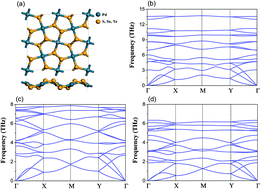Penta-PdX2 (X = S, Se, Te) monolayers: promising anisotropic thermoelectric materials†
Abstract
Thermoelectric materials can be used to convert waste heat into electrical energy, which is considered to be a cleaner form of energy that reduces carbon dioxide and greenhouse gas emissions. In this work, we study the thermoelectric properties of penta-PdX2 (X = S, Se, Te) using first-principles calculations together with Boltzmann transport theory. The dynamic and thermal stability of penta-PdX2 is confirmed based on phonon dispersion and ab initio molecular dynamics (AIMD) simulations. The transport coefficients, such as thermal conductivity (kl), power factor (PF) and thermoelectric figure of merit (ZT), exhibit strong anisotropy in both x and y directions. The lower thermal conductivity of penta-PdX2 can be attributed to the lower group velocity and larger phase space. The thermal conductivity of penta-PdX2 along the same direction (x or y direction) adheres to the trend of PdS2 > PdSe2 > PdTe2. The anisotropy of PF and kl of penta-PdX2 monolayers inevitably leads to anisotropy of ZT. The largest ZT values of penta-PdX2 (X = S, Se) for p-type are 0.85 and 1.18, respectively, while the maximum ZT value of penta-PdTe2 reaches 2.42. The predicted ZT values of penta-PdX2 are larger than those of the commercial TE material Bi2Te3 (about 0.8) and some other transition metal di-chalcogenides, indicating that penta-PdX2 (X = S, Se, Te) monolayers are potential anisotropic thermoelectric materials.



 Please wait while we load your content...
Please wait while we load your content...